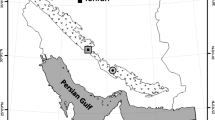Abstract
A study of the structural petrology of a peridotite exposed on Cypress Island in Skagit Co., Washington, U.S.A. has been carried out. The Cypress peridotite is, by virtue of its composition, structure and associations, typical of ultramafics of the alpine type. It contains relict layering and accumulative textures which show it to have originated by crystal settling from a magma of unknown initial composition. Parallelism of lineations and b-axes of folds in the layering with well-developed [100]-maxima in the fabrics of olivine crystals is considered to have arisen through a penetrative deformation of the mass accompanied by plastic flow or recrystallization of the olivine. An indication of the minimum temperature of the deformation is provided by cross-cutting veins of pyroxenite which have not participated in the folding. The most satisfactory interpretation of the overall fabric of the peridotite is that it was deformed, possibly during intrusion, as a crystal mush, and that filter pressing due to compaction of the solid particles by plastic flow or recrystallization removed all but a small percentage of the magmatic fraction which then crystallized following cessation of the movements.
Similar content being viewed by others
References
Bailey, E. B., andW. T. McCallien: Serpentine lavas, the Ankara melange and Anatolian thrust. Trans. Roy. Soc. Edinburgh62, part 2, 403–422 (1953).
Battey, M. H.: The relationship between preferred orientation of olivine in dunite and the tectonic environment. Am. J. Sci.258, 716–727 (1960).
—: The relationship between preferred orientation of olivine in dunite and the tectonic environment; Reply to a discussion byR. N, Brothers. Am. J. Sci.260, 313–315 (1962).
Bowen, N. L., andJ. F. Schairer: The system MgO-FeO-SiO2. Am. J. Sci.29, 151–217 (1935).
—, andO. F. Tuttle: The system MgO-FeO-SiO2-H2O. Bull. Geol. Soc. Am.60, 439–460 (1949).
Brothers, R. N.: Flow orientation of olivine. Am. J. Sci.257; 574–584 (1959).
—: The relationship between preferred orientation of olivine in dunite and the tectonic environment; A discussion. Am. J. Sci.260, 310–312 (1962).
Calnan, E. A., andC. J. B. Clews: Deformation textures in face-centred cubic metals. Phil. Mag.41, 1085–1100 (1950).
—: The prediction of uranium deformation textures. Phil. Mag.43, 93–104 (1952).
Chudoba, K. F., andJ. Frechen: Über die plastische Verformung von Olivin. Neues Jahrb. Abhandl., Abt. A.81, 183–200 (1950).
Clarke, R. H., andW. S. Fyfe: Ultrabasic liquids. Nature191, 158–159 (1961).
Hess, H. H.: A primary peridotite magma. Am. J. Sci.35, 321–344 (1938).
—: Serpentines, orogeny, and epeirogeny. Geol. Soc. Am. Spec. Paper62, 391–407 (1955).
— Stillwater igneous complex. Geol. Soc. Am. Mem.80 (1960).
Hotz, P. E., andE. D. Jackson: X-ray determinative curve for olivines of composition Fo80–95 from stratiform and alpine-type peridotites. U. S. Geol. Survey Prof. Paper460-E, 101–102 (1963).
Hubbert, M. K., andW. W. Rubey: Role of fluid pressure in mechanics of overthrust faulting. Bull. Geol. Soc. Am.70, 115–166 (1959).
Huntting, M. T.: Geological map of the State of Washington Washington State Division of Mines and Geology (1961).
Jackson, E. D.: Primary textures and mineral Associations 'in the ultramafic zone of the Stillwater complex, Montana, U. S. Geol. Survey Prof. Paper358 (1961).
Jones, K. A.: The significance of Schnitteffekt in petrofabric diagrams. Am. J. Sci.257, 55–62 (1959).
Kamb, W. B.: Ice petrofabric observations; Appendix: Preparation of orientation-density diagrams. J. Geophys. Research64, 1891–1909 (1959).
Knopf, E. B., andE. Ingerson: Structural petrology. Geol: Soc. Am. Mem.6 (1938).
Lipman, P. W.: Structure and origin of an ultramafic pluton in the Klamath Mountains, California. Am. J. Sci.262, 199–222 (1964).
Maxwell, J. C., andA. Azzaroli: Submarine extrusion of ultramafic magma. (Abs.) Geol. Soc. Am. Spec. Paper73, 203–204 (1962).
McClellan, R. D.: The geology of the San Juan Island s. Univ. Wash. Publs. Geol.2 (1927).
Noble, J. A., andH. P. Taylor: Correlation of the ultramafic complexes of south-eastern Alaska with those of other parts of North America and the world. Rept. XXIst Session Internat. Geol. Cong. Copenhagen, part 13, 188–197 (1960).
Ragan, D.: Emplacement of the Twin Sisters dunite, Washington. Am. J. Sci.261, 549–565 (1963).
Raleigh, C. B.: Fabrics of naturally and experimentally deformed olivine. Ph. D. Thesis,. University of California at Los Angeles 1963.
—: Glide mechanisms in minerals in experimentally deformed rocks determined by slip-trace technique. Science150, 739–741 (1965).
—, andM. S. Paterson: Experimental deformation of serpentinite and its tectonic implications. J. Geophys. Research70, 3965–3985 (1965).
Roever, W. P. de: Sind die Alpinotypen Peridotitmassen vielleicht tektonisch verfrachtete Bruchstücke der Peridotitschale? Geol. Rundschau46, 137–146 (1957).
Taylor, G. I.: The motion of ellipsoidal particles in a viscous fluid. Proc. Roy.. Soc. (London) A103, 58–61 (1923).
Terzhagi, K.: Simple tests determine hydrostatic uplift. Eng. News-Record116, 501–523 (1936).
Thayer, T. P.: Some critical differences between alpine type and stratiform peridotitegabbro complexes: Rept. XXIst Session Internat. Geol. Congr. Copenhagen, part 13, 247–259 (1960).
—: Flow-layering in alpine peridotite-gabbro complexes. Mineral. Soc. Am. Spec. Paper1, 55–61 (1963).
Turner, F. J.: Preferred orientation of olivine crystals in peridotites, with special reference to New Zealand examples. Roy. Soc. New Zealand Proc. Trans.72, 280–300 (1942).
—,H. C. Heard, andD. T. Griggs: Experimental deformation of enstatite and accompanying inversion to clinoenstatite. Rept. XXIst Session Internat. Geol. Congr. Copenhagen, part 18, 399–408 (1960).
—, andL. E. Weiss: Structural analysis of metamorphic tectonites. New York: McGrawHill Book Co. 1963. 545 p.
Weiss, L. E., andD. B. McIntyre: Structural geometry of Dalradian rocks at Loch Leven, Scottish Highlands. J. Geol.65, 575–602 (1957).
Author information
Authors and Affiliations
Rights and permissions
About this article
Cite this article
Raleigh, C.B. Structure and petrology of an alpine peridotite on Cypress Island, Washington, U.S.A. Beitr Mineral u Petrogr 11, 719–741 (1965). https://doi.org/10.1007/BF01128711
Received:
Issue Date:
DOI: https://doi.org/10.1007/BF01128711




